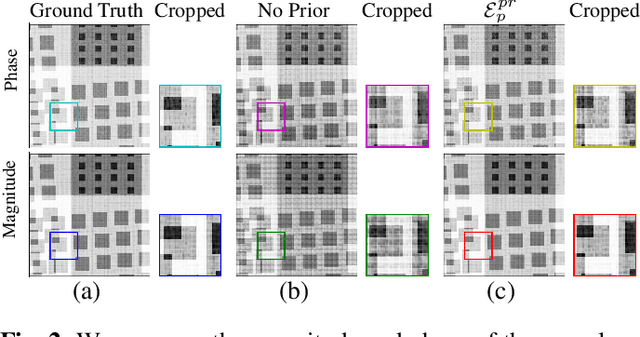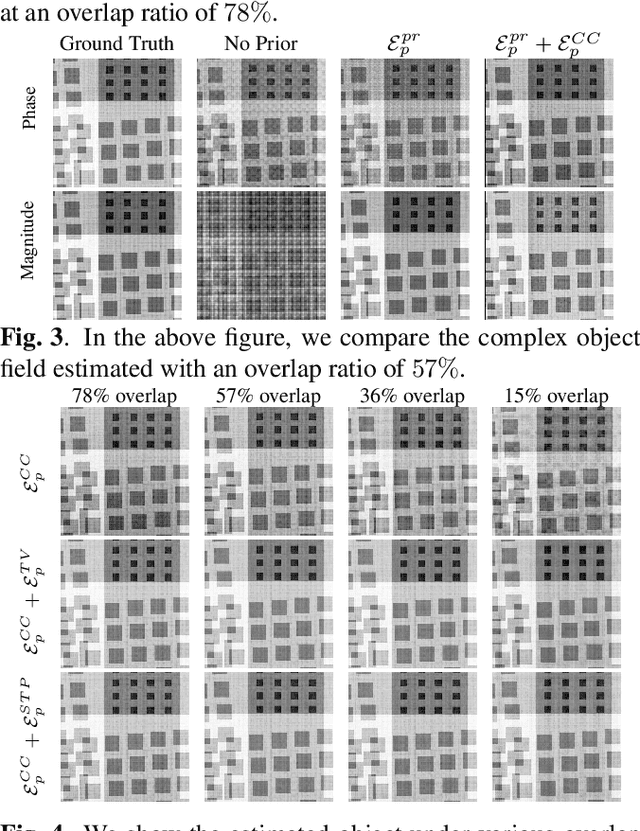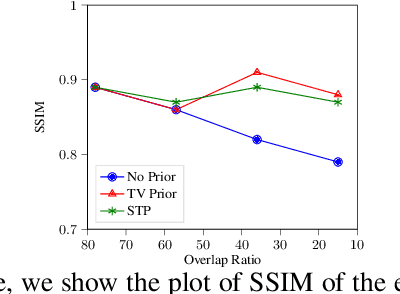Semih Barutcu
A Deep Generative Approach to Oversampling in Ptychography
Jul 28, 2022



Abstract:Ptychography is a well-studied phase imaging method that makes non-invasive imaging possible at a nanometer scale. It has developed into a mainstream technique with various applications across a range of areas such as material science or the defense industry. One major drawback of ptychography is the long data acquisition time due to the high overlap requirement between adjacent illumination areas to achieve a reasonable reconstruction. Traditional approaches with reduced overlap between scanning areas result in reconstructions with artifacts. In this paper, we propose complementing sparsely acquired or undersampled data with data sampled from a deep generative network to satisfy the oversampling requirement in ptychography. Because the deep generative network is pre-trained and its output can be computed as we collect data, the experimental data and the time to acquire the data can be reduced. We validate the method by presenting the reconstruction quality compared to the previously proposed and traditional approaches and comment on the strengths and drawbacks of the proposed approach.
Compressive Ptychography using Deep Image and Generative Priors
May 16, 2022



Abstract:Ptychography is a well-established coherent diffraction imaging technique that enables non-invasive imaging of samples at a nanometer scale. It has been extensively used in various areas such as the defense industry or materials science. One major limitation of ptychography is the long data acquisition time due to mechanical scanning of the sample; therefore, approaches to reduce the scan points are highly desired. However, reconstructions with less number of scan points lead to imaging artifacts and significant distortions, hindering a quantitative evaluation of the results. To address this bottleneck, we propose a generative model combining deep image priors with deep generative priors. The self-training approach optimizes the deep generative neural network to create a solution for a given dataset. We complement our approach with a prior acquired from a previously trained discriminator network to avoid a possible divergence from the desired output caused by the noise in the measurements. We also suggest using the total variation as a complementary before combat artifacts due to measurement noise. We analyze our approach with numerical experiments through different probe overlap percentages and varying noise levels. We also demonstrate improved reconstruction accuracy compared to the state-of-the-art method and discuss the advantages and disadvantages of our approach.
Improving Acquisition Speed of X-Ray Ptychography through Spatial Undersampling and Regularization
May 20, 2021



Abstract:X-ray ptychography is one of the versatile techniques for nanometer resolution imaging. The magnitude of the diffraction patterns is recorded on a detector and the phase of the diffraction patterns is estimated using phase retrieval techniques. Most phase retrieval algorithms make the solution well-posed by relying on the constraints imposed by the overlapping region between neighboring diffraction pattern samples. As the overlap between neighboring diffraction patterns reduces, the problem becomes ill-posed and the object cannot be recovered. To avoid the ill-posedness, we investigate the effect of regularizing the phase retrieval algorithm with image priors for various overlap ratios between the neighboring diffraction patterns. We show that the object can be faithfully reconstructed at low overlap ratios by regularizing the phase retrieval algorithm with image priors such as Total-Variation and Structure Tensor Prior. We also show the effectiveness of our proposed algorithm on real data acquired from an IC chip with a coherent X-ray beam.
 Add to Chrome
Add to Chrome Add to Firefox
Add to Firefox Add to Edge
Add to Edge